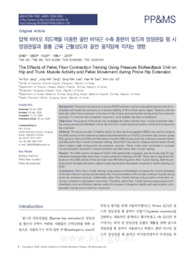

PARTNER
검증된 파트너 제휴사 자료
압력 바이오 피드백을 이용한 골반 바닥근 수축 훈련이 엎드려 엉덩관절 폄 시 엉덩관절과 몸통 근육 근활성도와 골반 움직임에 미치는 영향 (The Effects of Pelvic Floor Contraction Training Using Pressure Biofeedback Unit on Hip and Trunk Muscle Activity and Pelvic Movement during Prone Hip Extension)
8 페이지
최초등록일 2025.04.11
최종저작일
2024.06

-
미리보기
서지정보
· 발행기관 : 한국임상움직임치료학회
· 수록지 정보 : 한국임상움직임치료학회지 / 4권 / 1호 / 29 ~ 36페이지
· 저자명 : 장예은, 양종민, 이상민, 서해니, 고민주
초록
Objectives The purpose of this study is to investigate the effect of pelvic floor muscle contraction training using a pressure biofeedback unit on hip and trunk muscle activity and pelvic movement during prone hip extension.
Methods The study included 15 healthy adults. Surface electromyography (EMG) was used to measure the EMG activity of the transversus abdominis/internal oblique (TrA/IO), dominant side erector spinae (ES), gluteus maximus (GM), and hamstring muscles (HM) during prone hip extension exercise before and after pelvic floor muscle contraction training. Xsens DOT was used to measure anterior pelvic tilt and pelvic rotation angle during prone hip extension exercise. Paired t-test were conducted to compare muscle activation and pelvic movement before and after pelvic floor muscle training.
Results The EMG activity of bilateral TrA/IO, GM significantly increased, and dominant side ES significantly decreased after pelvic floor muscle contraction training (p <0.05). There was no significant difference in the EMG activity of the dominant side HM following pelvic floor muscle training. Both the anterior pelvic tilt angle and pelvic rotation angle significantly decreased compared to before training (p < 0.05).
Conclusions Pelvic floor muscle training using pressure biofeedback increases the muscle activation of the hip extensor muscles and decreases the muscle activation of the lumbar extensor muscles during prone hip extension exercise. Additionally, pelvic floor muscle training reduces pelvic movement, reducing unwanted compensatory movement. Therefore, pelvic floor muscle training using a pressure biofeedback unit is an effective training method to increase lumbopelvic stability and reduce pelvic compensation during lower extremity movement.영어초록
Objectives The purpose of this study is to investigate the effect of pelvic floor muscle contraction training using a pressure biofeedback unit on hip and trunk muscle activity and pelvic movement during prone hip extension.
Methods The study included 15 healthy adults. Surface electromyography (EMG) was used to measure the EMG activity of the transversus abdominis/internal oblique (TrA/IO), dominant side erector spinae (ES), gluteus maximus (GM), and hamstring muscles (HM) during prone hip extension exercise before and after pelvic floor muscle contraction training. Xsens DOT was used to measure anterior pelvic tilt and pelvic rotation angle during prone hip extension exercise. Paired t-test were conducted to compare muscle activation and pelvic movement before and after pelvic floor muscle training.
Results The EMG activity of bilateral TrA/IO, GM significantly increased, and dominant side ES significantly decreased after pelvic floor muscle contraction training (p <0.05). There was no significant difference in the EMG activity of the dominant side HM following pelvic floor muscle training. Both the anterior pelvic tilt angle and pelvic rotation angle significantly decreased compared to before training (p < 0.05).
Conclusions Pelvic floor muscle training using pressure biofeedback increases the muscle activation of the hip extensor muscles and decreases the muscle activation of the lumbar extensor muscles during prone hip extension exercise. Additionally, pelvic floor muscle training reduces pelvic movement, reducing unwanted compensatory movement. Therefore, pelvic floor muscle training using a pressure biofeedback unit is an effective training method to increase lumbopelvic stability and reduce pelvic compensation during lower extremity movement.참고자료
· 없음 -
자주묻는질문의 답변을 확인해 주세요

꼭 알아주세요
-
자료의 정보 및 내용의 진실성에 대하여 해피캠퍼스는 보증하지 않으며, 해당 정보 및 게시물 저작권과 기타 법적 책임은 자료 등록자에게 있습니다.
자료 및 게시물 내용의 불법적 이용, 무단 전재∙배포는 금지되어 있습니다.
저작권침해, 명예훼손 등 분쟁 요소 발견 시 고객센터의 저작권침해 신고센터를 이용해 주시기 바랍니다. -
해피캠퍼스는 구매자와 판매자 모두가 만족하는 서비스가 되도록 노력하고 있으며, 아래의 4가지 자료환불 조건을 꼭 확인해주시기 바랍니다.
파일오류 중복자료 저작권 없음 설명과 실제 내용 불일치 파일의 다운로드가 제대로 되지 않거나 파일형식에 맞는 프로그램으로 정상 작동하지 않는 경우 다른 자료와 70% 이상 내용이 일치하는 경우 (중복임을 확인할 수 있는 근거 필요함) 인터넷의 다른 사이트, 연구기관, 학교, 서적 등의 자료를 도용한 경우 자료의 설명과 실제 자료의 내용이 일치하지 않는 경우
“한국임상움직임치료학회지”의 다른 논문도 확인해 보세요!
-
팔 들어올리기 운동 시 압력 바이오피드백 사용 유무에 따른 위등세모근과 아래등세모근의 근활성도 비교 8 페이지
Background Excessive muscle activation of the upper trapezius and decreased muscle activation of the lower trapezius can lead to changes in scapulohumeral rhythm. Many studies suggest that arm lift ex.. -
스쿼트 운동 시 탄력밴드를 이용한 상지 저항 방향 변화가 하지 근활성도에 미치는 영향 9 페이지
Background Patients with patellofemoral pain syndrome show weakness of the vastus medialis oblique (VMO) and gluteus maximus (GMax) muscles. Closed chain exercises, such as squats, are more effective .. -
아치테이핑이 유연성 평발을 가진 대상자의 Y-Balance Test와 무릎과 발목의 관절가동범위에 미치는 영향 10 페이지
Background Flatfoot causes kinematic changes in the lower extremities and poor postural control, and it acts as a risk factor for lower extremity injury. Arch taping is used clinically as an intervent.. -
물리치료학과 전공수업에 적용한 3L-복합학습설계의 분석 9 페이지
Background The purpose of this study was to apply learning methods to maximize the efficiency of education in physical therapy, which is a health field. Objectives It was intended to propose the effec..
문서 초안을 생성해주는 EasyAI
